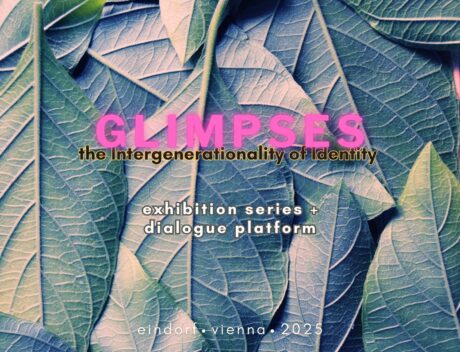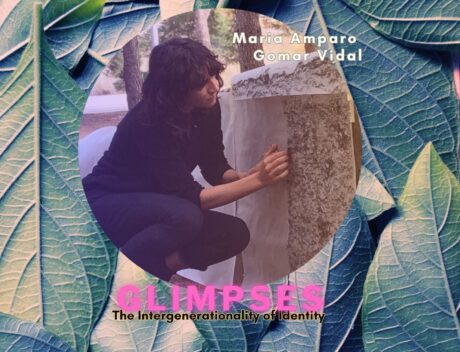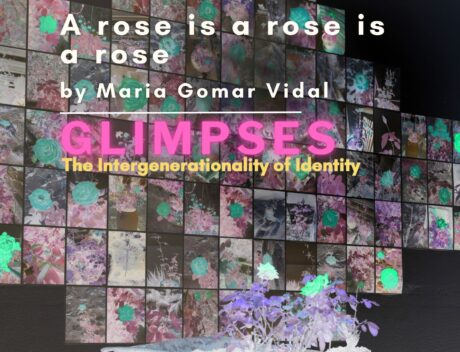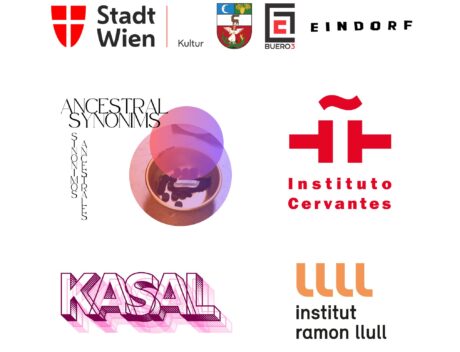A rose is a rose is a rose
by Maria Amparo Gomar Vidal
in the frame of GLIMPSES: the intergenerationality of identity
Opening: 05. Juni um 19:00
exhibition duration: 5. – 21. Juni 2025
other visiting dates on request: eindorf.kunstraum@gmail.com
In A rose is a rose is a rose, Maria Amparo Gomar Vidal creates a counter-monument to victims of Franco’s violence Spain, particularly in Paterna. Rooted in collective memory and community resistance, the installation combines photography, video, and symbolic gestures — like the planting of roses — developed in collaboration with local women. Inspired by a single rose discovered during a mass grave exhumation, the work reflects on political trauma, inherited mourning, and the healing power of remembrance.
Aligning with the core of GLIMPSES: the intergenerationality of identity, Gomar Vidal’s project explores how personal and historical memory is passed down through generations. It asks: How do communities reclaim silenced histories? What rituals emerge from the need to honor the past? The work emphasizes intergenerational dialogue, the emotional weight of inherited memory, and the resilience of those who continue to carry it forward.
The following persons are part of this project:
Maruja Badía, Maria Navarro, Teresa Llopis, Pilar Taberner, Xaro Laporta, Romy Brühwiler, Ileana Pascalau, Anaïs Senli, Daniel Galán, Nora Ancarola, Amanda Cuesta, Elena Tamarit, Elena Solanas, Amparo Belmonte, M. José Sánchez, Paula Pérez, José Ángel Sánchez, Alona Malakhaeva, Vanesa Peña, Ofèlia Sanmartín, Eva Máñez.
more about the series „GLIMPSES: The Intergenerationality of Identity“ here
A project by Ancestral Synonyms and KASAL in collaboration with eindorf.
Curated by Guadalupe Aldrete
Funded by MA7 Department of Culture of the City of Vienna and the 15th District of Vienna
Image credits: Project participants & Maria Amparo Gomar Vidal
Dieses Gegen-Denkmal aus Fotografien, Videos und Skulpturen ehrt die nach dem Spanischen Bürgerkrieg (1936-39) in Paterna Ermordeten. Seit 2020 hat Maria mit Mitgliedern der lokalen Gemeinde – viele von ihnen Verwandte der Verstorbenen – zusammengearbeitet, um rund 300 Bilder von Rosen zu sammeln.
Das Projekt wurde durch Berichte über eine Rose inspiriert, die bei der Ausgrabung des Massengrabs 128 im Jahr 2018 auf dem Friedhof von Paterna entdeckte wurde. Der Historiker Dr. Vicent Gabarda schreibt, dass zwischen 1939 und 1956 2.238 unschuldige Menschen (2.218 Männer und 20 Frauen) auf dem als „El Terrer“ bekannten Militärgelände unmittelbar nach dem Bürgerkrieg aus ideologischen Gründen und mit illegalen Mitteln hingerichtet wurden. Derzeit befinden sich auf dem Friedhof 153 identifizierte Gräber.
Die in Grab Nr. 128 bestatteten Personen wurden 1941 getötet. 128 wurden 1941 ermordet, und der Akt, dort Rosen niederzulegen, kam wahrscheinlich von der Familie eines der Opfer. Daniel Palacios betont, dass die Kranzniederlegung an den Massengräbern ein bedeutender Akt der Bewusstseinsbildung gegen staatliche Gewalt ist. Frauen, darunter Witwen, Schwestern, Mütter und Töchter, durften außer an Allerheiligen oft nicht öffentlich ihrer Angehörigen gedenken.
In Anlehnung an Gertrude Steins berühmten Satz „Eine Rose ist eine Rose ist eine Rose“ steht der Akt des Widerstands, den die Rose symbolisiert, im Mittelpunkt des Projekts. Maria stellte den Mitgliedern der Gemeinschaft, die sich für die Erinnerungsarbeit engagieren, Rosensträucher und Erde aus den Massengräbern auf dem Friedhof von Paterna zur verfügung. Diese engagierten Teilnehmer – zumeist Frauen – pflanzten die Rosensträucher mit der Erde ein und teilten ihr Bilder der Blüten mit, so dass sie dieses visuelle Archiv aufbauen konnte. Zusätzlich zu den Fotos sammelte sie Videos, die den Verpflanzungsprozess dokumentieren.
Dieses Gegen-Denkmal dient als Geste der symbolischen Wiedergutmachung und unterstreicht das Engagement der Teilnehmer für die Menschenrechte und die Bedeutung des kollektiven Gedächtnisses. Indem es die Geschichte und die Erfahrungen der von politischer Gewalt Betroffenen würdigt, trägt das Projekt zur Erforschung der Identitätskonstruktion bei und schafft einen Raum für Heilung und Reflexion, der die zum Schweigen gebrachten Verbrechen der Franco-Diktatur anerkennt und gleichzeitig die Widerstandsfähigkeit der Gemeinschaft und das Bewusstsein für die Gefahren des Faschismus stärkt.
*
“This artistic project approaches the bonds of affection and solidarity that are generated in the processes of memory in order to situate them in the contemporary context with the aim of pointing out their value in the framework of human rights.
The trigger for the work was a story published on social networks, which referred to a rose found during the exhumation of mass grave no. 128 in Paterna (Valencia), where two images of the rose were shown, the original one, and another coloured in red.
The rose was probably placed in the mass grave in 1941 as a tribute by a relative. Dr. Daniel Palacios, art historian, notes that ‘the return to the mass graves for the floral offering represents a first and subversive moment of consciousness-raising and explicit conscious opposition with the own body to the state and its monopoly of violence’.
To contextualise, according to the research of the Paternero historian Dr. Vicent Gabarda, between 1939 and 1956, 2,238 people (2,218 men and 20 innocent women) were murdered in the local military site known as ‘El Terrer’ and close to the municipal cemetery, for ideological reasons and with illegal procedures, immediately after the civil war. Nowadays, the number of mass graves counted in this municipality amounts to 153, according to the map of mass graves of the Valencian Community (GVA).
This artistic work has been generated around the graves of Paterna through which the people (most of them women, including some of granddaughters of the victims who were buried in the graves) who have been involved in these processes and/or have served as accompaniment, have received a rose bush with earth from the grave, in allusion to the rose found in mass grave no. 128. The participants, friends and companions with whom I have a very special bond, transplanted the rose bushes and committed themselves to taking care of them and to sending images of the roses through social networks, during the season in which the roses bloom.
The aim of this work is to bring to society other ways of remembering outside the visual context of violence that is usually associated with this subject, in order to reach an interested public but also a general public of young people and adults who are not familiar with this subject.
In this way, the intention is to avoid the re-victimisation of the affected families while showing a part of the process of memory that is not usually contemplated in the discourses linked to this subject.
The artistic transformation of these emotional ties consists of a decentralised counter-monument, which could operate as a symbolic reparation for all those involved in this process.”
Text by Maria Amparo Gomar Vidal
bio
María Amparo Gomar Vidal (*1983, Valencia) lebt und arbeitet in Berlin. Sie hat ihr Studium der Bildenden Künste mit Schwerpunkt Malerei an der Fakultät der Schönen Künste San Carlos der Polytechnischen Universität Valencia (2009) abgeschlossen, nahm am Continuing Education Program der School of Visual Arts in New York (2011) teil und absolvierte den Master „Art in Context“ mit Schwerpunkt Künstlerische Museumsstudien an der Universität der Künste Berlin (2015).
In ihrer künstlerischen Praxis untersucht sie Themen wie Erinnerung, Geschlecht und Identität. Beeinflusst durch den deutschen Begriff der „Vergangenheitsbewältigung“ konzentriert sich ihre jüngste Arbeit auf die Soziologie des Franquismus und das Erbe der Diktatur in öffentlichen und verborgenen Räumen. Ihre Forschung befasst sich zudem mit kollektiven Reparatur- und Affektprozessen. Der Ansatz ihrer Kunst ist partizipativ und kombiniert pädagogische Werkzeuge mit Malerei, Zeichnung, Video und Installation.
Ihre Werke wurden in Deutschland im Instituto Cervantes Berlin, in der Spanischen Botschaft, im SomoS Art House, GlogauAIR, der KulturMarktHalle, der Universität der Künste, der Meinblau Galerie sowie in den Galerien Benau und Bohai in Hannover gezeigt. In Spanien wurden ihre Arbeiten im Born Culture and Memory Center in Barcelona, dem Centre del Carme de Cultura Contemporània (CCCC) in Valencia, dem Stadtmuseum Valencia, dem Kulturzentrum La Nau der Universität Valencia und im Kulturzentrum Las Cigarreras Alicante sowie im Museum der Universität Alicante ausgestellt. Weitere internationale Ausstellungen umfassen die School of Visual Arts New York (USA), die York University (UK) und das Centro de Memoria, Paz y Reconciliación in Bogotá (Kolumbien).
more about
GLIMPSES. The Intergenerationality of Identity
exhibition series and dialogue platform
A project by Ancestral Synonyms and KASAL in collaboration with eindorf
FULL PROGRAM
Spring 2025 (pre-summer events):
Exhibition 1 – May 15th – 31st, 2025 – Louise Deininger
Discussion round – June 10th, 2025 – Guest curator Frida Robles Ponce
Exhibition 2 – June 5th – 21st, 2025 – Maria Gomar Vidal
Exhibition 3 – July 3rd – 19th, 2025 – Guadalupe Aldrete
Autumn 2024 (events after the summer):
Exhibition 5 – September 3rd – 21st, 2025 (life – event: 05.09) – Rafael Lippuner
Exhibition 6 – November 5th – 17th, 2025 – Paula Flores
Exhibition 7 – November 27th – December 13th, 2025 – Bettina Eigner
Performative event – December 17th, 2025 – Nina Sandino
An exploration of memory, ancestry, and the invisible threads that shape who we are
How do inherited memories move through bodies, landscapes, and materials? What stories live in scars, rituals, silence, and everyday gestures?
GLIMPSES brings together Louise Deininger, Maria Amparo Gomar Vidal, Guadalupe Aldrete, Rafael Lippuner, Paula Flores, Bettina Eigner, Nina Sandino, a group of artists whose works navigate the layered terrain of identity across generations. From performative landscapes and sculptural counter-monuments to sound-based rituals and immersive installations, the project explores the somatic, poetic, and political dimensions of ancestry.
Developed by the curatorial platform Ancestral Synonyms and presented in the spaces of eindorf, this year-long program unfolds in a series of solo exhibitions, performances, and conversations. Each artistic position invites us to pause, reflect, and listen – to the whispers of those who came before, and the echoes they leave behind.
Whether working with familial trauma, ancestral wisdom, or the body as archive, the artists in GLIMPSES ask:
What do we carry, what do we transform, and what do we choose to remember?
A project by Ancestral Synonyms and KASAL in collaboration with eindorf.
Project initiated and curated by Guadalupe Aldrete
Funded by MA7 Department of Culture of the City of Vienna and the 15th District of Vienna
[/lgc_column]




